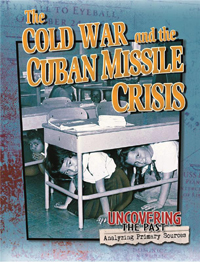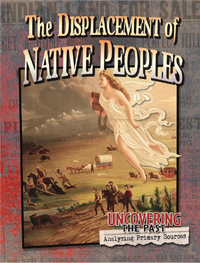| ________________
CM . . .
. Volume XXII Number 36. . . .May 20, 2016

 |
The Cold War and the Cuban Missile Crisis. (Uncovering the Past: Analyzing Primary Sources).
Natalie Hyde.
St. Catharines, ON: Crabtree, 2016.
48 pp., pbk., hc. & html, $11.95 (pbk.),$29.36 (List RLB), $23.49 (School RLB).
ISBN 978-0-7787-2572-5 (pbk.), ISBN 978-0-7787-2570-1 (RLB), ISBN 978-1-4271-1760-1 (html).
Subject Headings:
Cold War-Sources-Juvenile literature.
Cuban Missile Crisis, 1962-Sources-Juvenile literature.
Grades 5-9 / Ages 10-14.
Review by Suzanne Pierson.
**** /4
|
| |
|
 |
The Displacement of Native Peoples. (Uncovering the Past: Analyzing Primary Sources).
Lynn Leslie Peppas.
St. Catharines, ON: Crabtree, 2016.
48 pp., pbk., hc. & html, $11.95 (pbk.),$29.36 (List RLB), $23.49 (School RLB).
ISBN 978-0-7787-2573-2 (pbk.), ISBN 978-0-7787-2571-8 (RLB), ISBN 978-1-4271-1761-8 (html).
Subject Headings:
Indians, Treatment of-Canada-History-Sources-Juvenile literature.
Indians, Treatment of-United States-History-Sources-Juvenile literature.
Indians of North America-Canada-Government relations-History-Sources-Juvenile literature.
Indians of North America-United States-Government relations-History-Sources-Juvenile literature.
Grades 5-9 / Ages 10-14.
Review by Suzanne Pierson.
**** /4
|
| |
|

excerpt:
Finding Reliable Sources
Primary sources are always more reliable sources of historical information than secondary sources. But some primary sources are considered to be better than others. This also holds true for secondary sources. The best primary or secondary sources are those created closest in time to the historical events under consideration.
For example, if a witness gave an account minutes after an event happened, it would be fresh in their memory. 30 years later, their account would still be considered a primary source, but the earlier account would be the more reliable of the two. (From The Displacement of Native Peoples.)
Again I am impressed with the two latest books in the “Uncovering the Past: Analyzing Primary Sources” series, The Cold War and the Cuban Missile Crisis and The Displacement of Native Peoples. (See Volume 22 Number 2 and Volume 22 Number 12 for reviews of earlier books in the series.)
Identifying bias, prejudice, and perspective, and learning to examine more than one source of information are important research skills for all students. The series, aimed at middle school students, uses eye-witness accounts, photographs, art work, illustrations, and newspaper reports of the period to teach students how to think critically about their sources of information. Each book ends with a look at a present-day example of similar events, as evidence, sadly, that history does repeat.
Each book includes a table of contents, a timeline of events which includes a map, a bibliography including quotation references, a glossary and an index. Also included in each book are “Internet Guidelines” with questions such as, “Can you verify the facts with another site? Always double check information.” That feature alone makes these books invaluable.
The Cold War and the Cuban Missile Crisis provides an opportunity for students to examine a significant world event in recent history. The Cuban Missile Crisis took place in the early 1960s. Unlike more distant historical events, students will be likely be able to speak to adults in their families or communities who lived through the time period of the Cold War and the Cuban Missile Crisis. Many public and personal artifacts from that time period are readily available. Many other records of the Cold War between the United States and Russia were classified. Through the examples used in this book, students have an excellent opportunity to compare the different versions of events portrayed by different countries.
The outcome of the Cold War was important to all countries around the world. Every move was carefully watched and commented on by international newspapers, magazines, and television reporters. This left a large paper and photograph trail.
The Displacement of Native Peoples examines several different perspectives on the European settlement of North America. The timeline at the end of the book covers the time period from “1492 Christopher Columbus discovers the Americas” to “2008 Canadian prime minister Stephen Harper publically apologizes to Native peoples for residential schools and assimilation policies” and “2010 U.S. president Barack Obama signs the North American Apology Resolution Bill into law.”
Excerpts from letters and reports from government agents, a transcript of a speech by Tecumseh, maps from the 1800s, and modern day photographs are all used to present a comprehensive perspective on the displacement of Native people. The Oka Crisis in 1990 is discussed in some detail.
Analyze This
A Mohawk warrior stares at a Canadian soldier on September 2, 1990. Can you tell which figure in this photograph is the Mohawk warrior and which is the soldier? What is the soldier carrying? Look at the people in the background of the two figures in green. Many appear to be holding cameras and microphones. Who are these people and what do you think they are doing there?
The issue of the displacement of Native peoples is an ongoing event. Following the pattern of other books in this series, the author, Lynn Peppas, includes a chapter titled “Modern Examples: Displacement Today”. The plight of the Syrian refugees is presented.
Like the previous books in the series “Uncovering the Past: Analyzing Primary Sources”, both The Cold War and the Cuban Missile Crisis and The Displacement of Native Peoples will be important resources to help students improve their skills in examining evidence critically for bias and reliability.
Highly Recommended.
Suzanne Pierson is a retired teacher-librarian, currently instructing Librarianship courses at Queen’s University in Kingston, ON.

To comment
on this title or this review, send mail to cm@umanitoba.ca.
Copyright © the Manitoba Library Association. Reproduction for personal
use is permitted only if this copyright notice is maintained. Any
other reproduction is prohibited without permission.
Next Review | Table of Contents For This Issue - May 20, 2016
CM Home | Back Issues
| Search
| CM Archive
| Profiles Archive
|

